Aloe vera is a beautiful, sturdy succulent that is popular worldwide. Aloe vera is known for its fleshy green leaves, but seeing them turn yellow can be disheartening. Let’s find out why an aloe vera turns yellow.
Aloe vera primarily turns yellow due to overwatering, underwatering, overfertilization, direct sun exposure, and fluctuating temperatures. With proper identification of the problem and the right treatment, you can fix the yellow leaves on your aloe vera plant.
If your aloe vera leaves are turning yellow and you’re worried about your beautiful succulent, you are at the right place. We will discuss the reasons behind yellow leaves and how to fix them.
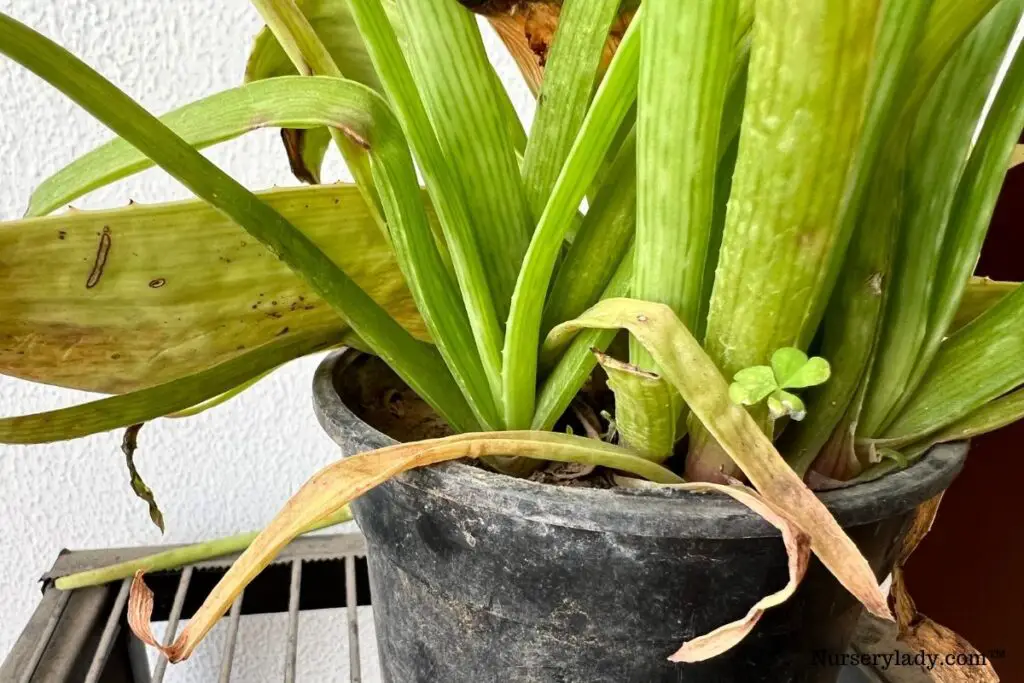
Why does aloe vera turn yellow?
Your aloe vera plant can turn yellow due to various reasons.
If you want to bring the succulent back to health, you need to identify the issue first so you can address it and fix it.
The various reasons that cause yellow leaves on aloe vera are:
- Overwatering
- Underwatering
- Too much sunlight
- Low light
- Lack of nutrients
- Overfertilization
- Diseases
- Pest infestation
- Temperature fluctuations
- Repotting shock
Now, let’s understand how these issues lead to yellow leaves.
Overwatering
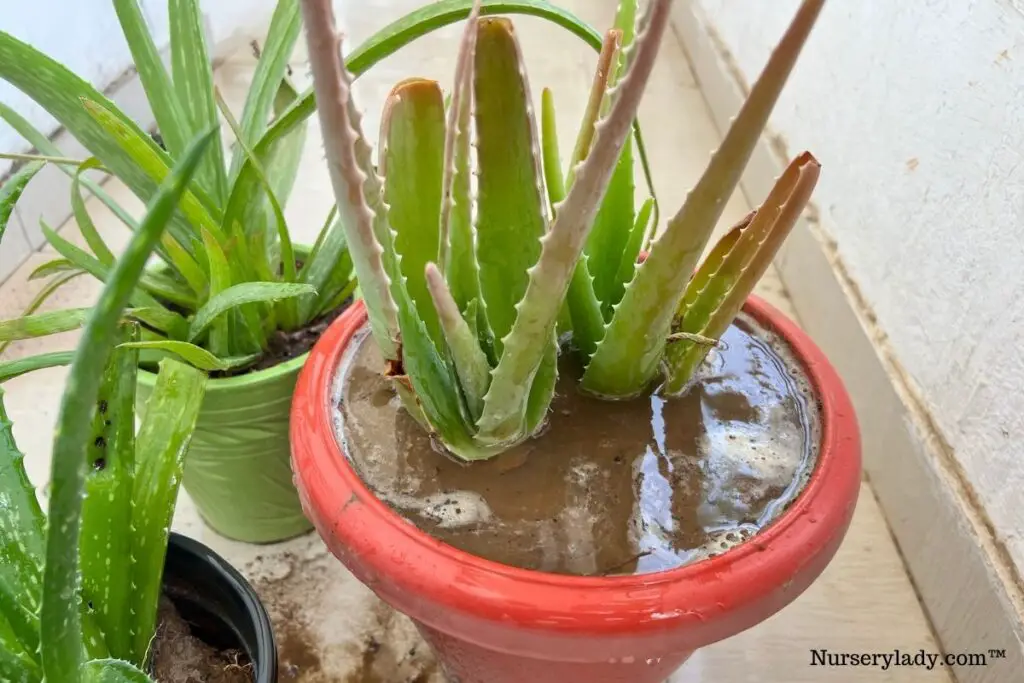
Like all succulents, Aloe vera doesn’t need a lot of water.
Aloe vera requires water only when the soil is dry.
But, if you water your Aloe vera without checking the soil’s moisture, you are overwatering it.
When you give excess water to your Aloe vera, the soil gets saturated, and the roots suffocate due to lack of oxygen.
This condition can proceed to root rot.
Unhealthy roots fail to absorb nutrients from the soil, making the aloe vera weak and its leaves yellow.
When you overwater your aloe vera, a part of the leaf may turn yellow.
Sometimes, the entire plant might start turning yellow from the base.
Solution:
If your aloe vera is turning yellow due to overwatering, you should do these:
- Stop watering the succulent.
- Keep it in bright direct sunlight and let the soil get dry.
- If you suspect root rot, take the succulent out of its pot and check the roots.
- If the roots appear brown and soft, prune them with a sterilized, sharp pruner.
- Spray a fungicide on the healthy roots before repotting the plant in a fresh succulent mix and new pot.
- Trim the yellow leaves as they will not bounce back to health.
Check the soil’s moisture with a moisture meter before watering your Aloe vera to prevent overwatering.
And keep in mind that aloe vera is succulent, so it doesn’t require as much water as your other houseplants.
An aloe vera will generally require watering once in 2-3 weeks.
Also read: How To Water Aloe Vera Plant? (How often, Summer, Winter)
Underwatering
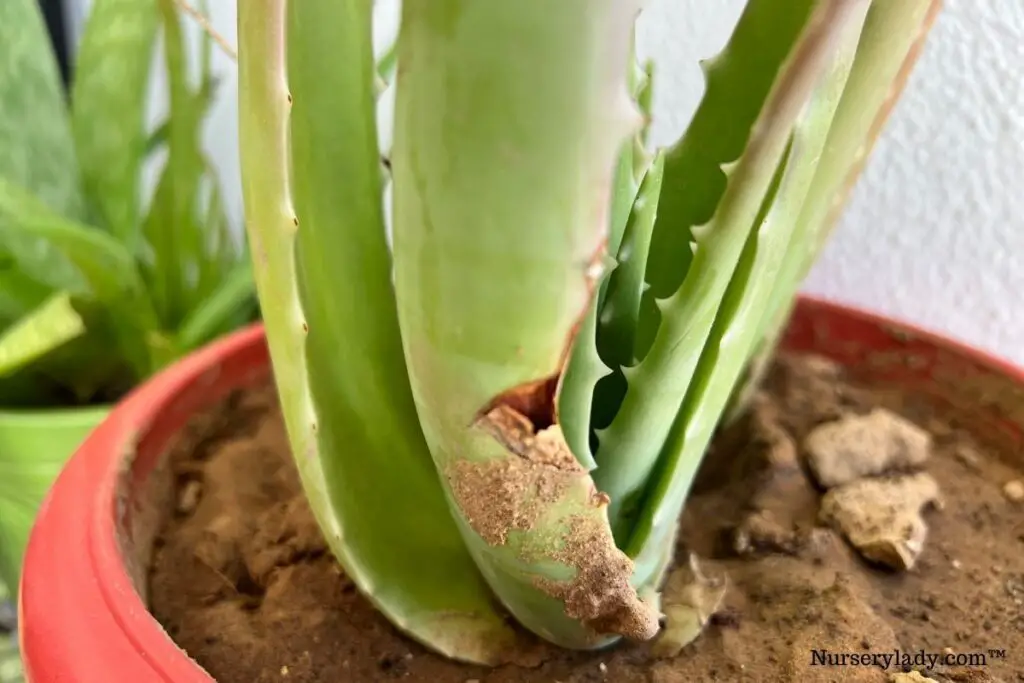
Sometimes people believe that a succulent will not require watering or thrive with very little watering.
However, that is not true.
Although aloe vera can tolerate dry conditions pretty well, it will require watering at some point.
If you neglect watering it, it will become dehydrated, and its leaves will lose all moisture and turn yellow.
In underwatering, the leaves turn yellow from the tips and move to the entire leaf.
The leaf tips can also start turning brown.
Solution:
If you have a dehydrated aloe vera plant with yellow leaves, do the following:
- Take a chopstick and aerate the soil and give the plant some water.
- Once the plant soaks up the water, give it more till the excess water starts draining out of the drainage holes.
To prevent underwatering your aloe vera, use a calendar that reminds you to check the soil.
If the soil is dry, you should water your aloe vera and if it feels wet, wait for the soil to dry.
Looking for gardening supplies? We have tested 100's of products before recommending them to you guys. Check out our best pick below:
| Image | Gardening Supplies | Best Price? |
|---|---|---|
 Top
Top Top
Top | Raised Garden Bed Kit | Check On Amazon |
 | XLUX Soil Moisture Meter, Plant Water Monitor, Soil Hygrometer Sensor for Gardening, Farming, Indoor and Outdoor Plants, No Batteries Required | No Results |
 Top
Top Top
Top | 82 Pcs Garden Tools Set and Extra Succulent Tools Set | Check On Amazon |
 | Joeys Garden Expandable Garden Hose with 8 Function Hose Nozzle, Lightweight Anti-Kink Flexible Garden Hoses, Extra Strength Fabric with Double Latex Core, (50 FT, Black) | No Results |
 Top
Top Top
Top | Dual Chamber Compost Tumbler | Check On Amazon |
 Top
Top Top
Top | Sunnyglade Plant Stakes | Check On Amazon |
 Top
Top Top
Top | Organic Cold Pressed Neem Seed Oil | Check On Amazon |
 Top
Top Top
Top | Mighty Mint Gallon :-Insect and Pest Control Peppermint Oil | Check On Amazon |
 Top
Top Top
Top | Scotts DiseaseEx Lawn Fungicide | Check On Amazon |
 Top
Top Top
Top | Jacks Classic 20-20-20 All Purpose Fertilizer | Check On Amazon |
 Top
Top Top
Top | 30,000 Seeds Pollinator Attracting Wildflower Mixture | Check On Amazon |
 Top
Top Top
Top | Survival Vegetable Seeds Garden Kit-Over 16,000 Seeds | Check On Amazon |
Too much sunlight
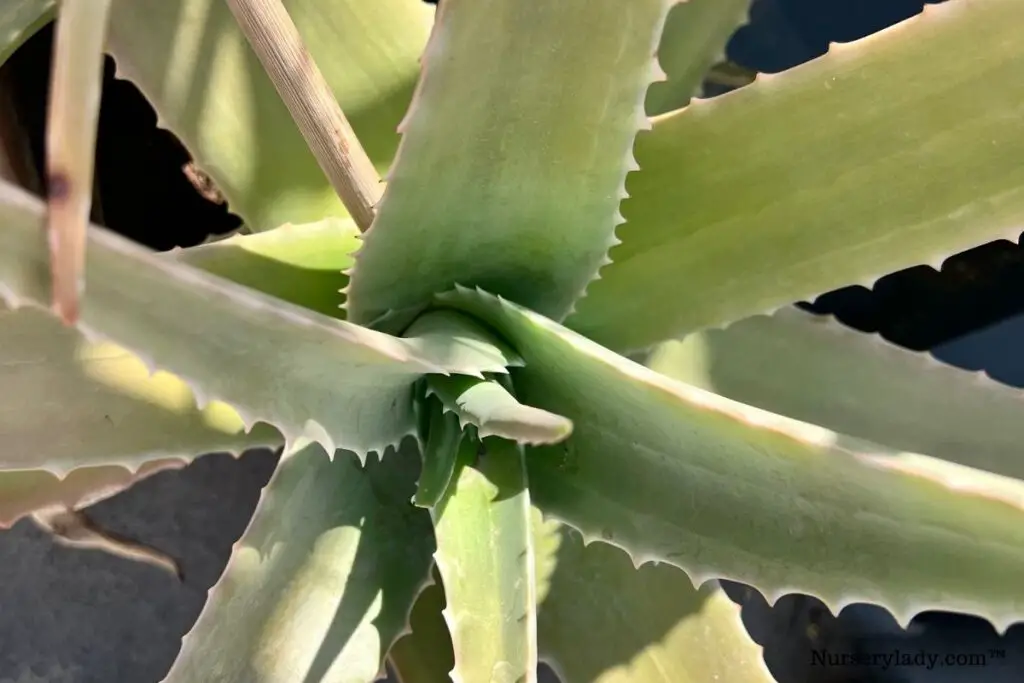
Aloe vera plants need at least 6 hours of direct sunlight, but they will not enjoy the harsh sunlight during the summer afternoons.
If you have placed your Aloe vera outside or near a south-facing window, it might be receiving too much sunlight.
If you don’t protect the plant from the intense heat and light, it will get sunburned, and the leaves will scorch.
Due to getting scorched, the leaves will turn pale and lose their color and look yellow.
Solution:
If the sunburn is the reason behind yellow leaves on your aloe vera, you must first relocate it to a location where it will not receive too intense sunlight.
Once you are done relocating your aloe vera, you must water the plant thoroughly.
You can either aerate the soil and then water the plant or take it out of its pot, put it in a container filled with water, and let the soil soak it.
If your aloe vera is placed or planted outside, you fix a shading net over it to protect it from the intense rays of the sun.
Also read: What Kind Of Light For Aloe Vera Plants? (Full sun, Shade, Or Partial Light?)
Low light
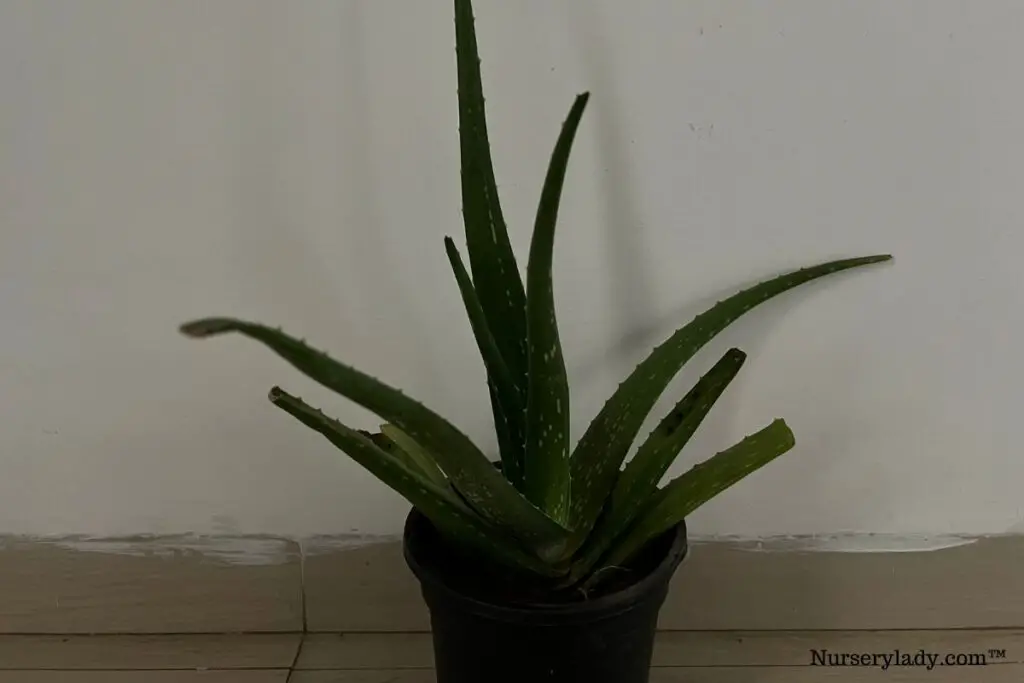
Aloe vera plants can’t survive in low light conditions.
It is not one of the low-light plants and requires at least 6 hours of direct sunlight.
If you have placed your aloe vera in an area not receiving enough light, the plant will experience many problems, including yellow leaves.
Due to lack of light, the chlorophyll that is responsible for the green color in plants reduces, and therefore, they turn yellow.
The leaves go pale and eventually turn yellow and soft.
Solution:
If you observe the plant throughout the day and notice that it is not getting enough light, move it to a sunnier spot.
Find a spot where your aloe vera will get bright direct sun for 6 hours, followed by indirect light.
Low light conditions are more likely in winter as the intensity and duration of light reduce during this time.
You can get artificial lights to provide more light to your aloe vera during winters.
Also read: Is Aloe Vera Indoor Or Outdoor Plant? (+Care Difference)
Overfertilization
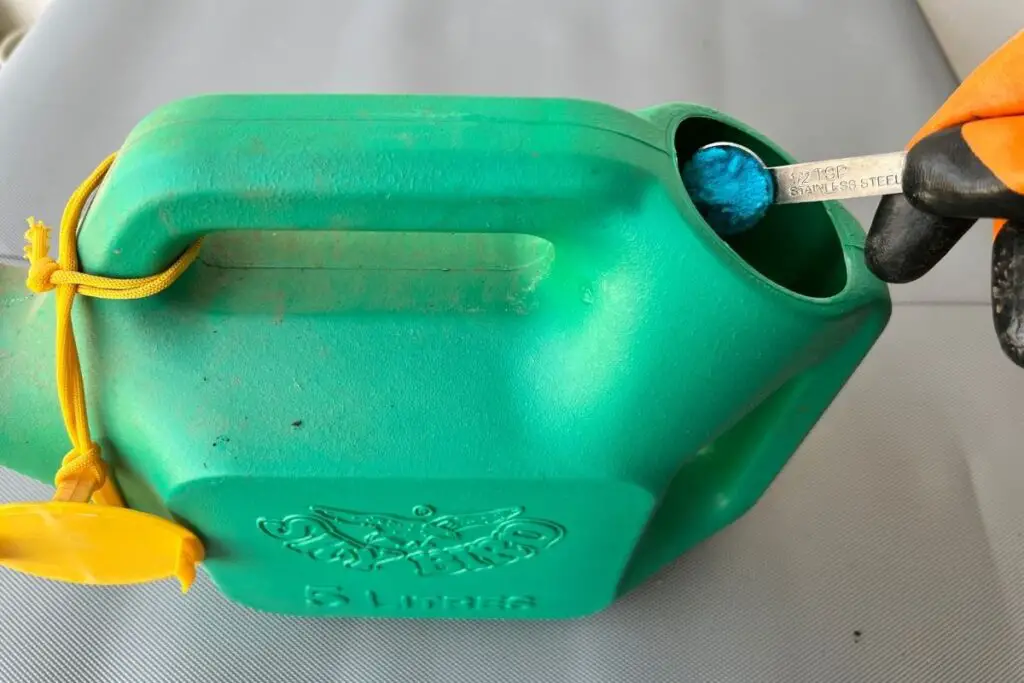
Overfertilization means you have fertilized your Aloe vera more than it needed.
However, if you haven’t repotted your aloe vera for too long, the fertilizer build-up on the soil.
The macronutrients that fertilizers contain, such as Nitrogen, Phosphorus, and Potassium, get converted to chemical salts, and over time, these salts create a crust on the soil.
These chemicals can damage the roots of your Aloe vera.
When you overfertilize your aloe, it starts turning yellow evenly.
Solution:
If your aloe vera is overfertilized, do the following:
- If you notice a thin crust on the soil, scrape it off.
- Put the plant in the sink and run water over the soil 2-3 times.
- You can also repot your aloe vera if you haven’t done it in a while.
To ensure you don’t overfertilize your aloe vera, avoid fertilizing more than once or twice a year.
You must also avoid using tap water on your aloe vera, which contains harmful minerals that damage the roots.
You can start using filtered water or rainwater to water your aloe vera.
You can also leave tap water overnight and use it on your aloe vera.
Also read: Does Aloe Vera Need Fertilizer? (How Much, How Often+Best Pick)
Lack of nutrients
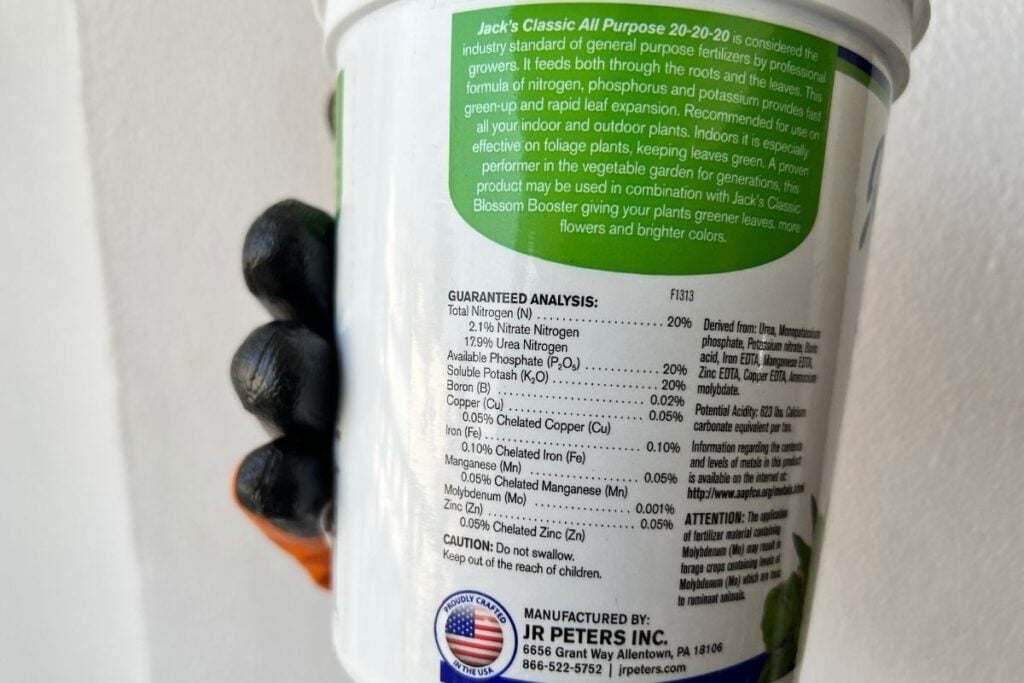
Although aloe vera can thrive with very little care, it still would need some nutrients to grow.
The aloe vera plant will fail to produce enough nutrients to maintain its green color.
Therefore, the leaves will turn yellow.
Lack of important macronutrients like Nitrogen can also lead to yellow leaves.
Solution:
If you are not fertilizing your aloe vera, start doing it.
You can use a fertilizer with an NPK ratio of 10:40:10.
You should also use a proper succulent soil mix for your aloe vera other than fertilizing.
Temperature fluctuations
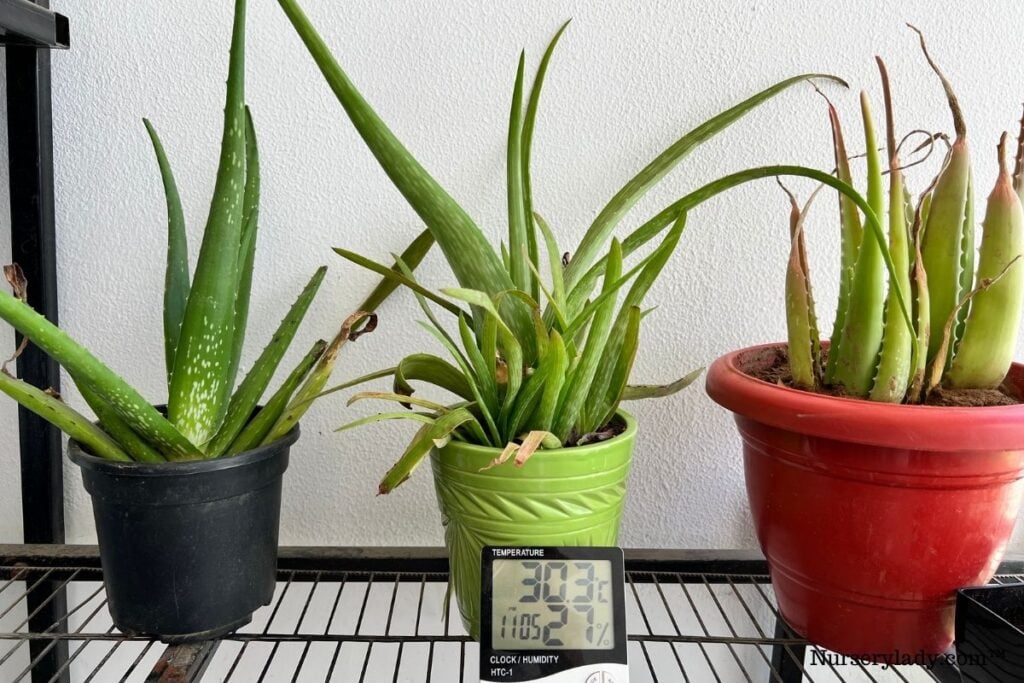
Most plants don’t prefer temperature fluctuations.
Aloe vera plants prefer temperatures between 55-80°F, but the plant will get stressed if the temperatures start rising or going low.
Frost can even kill your aloe vera plant.
So, if your aloe vera has been staying within the wrong temperature range or receiving temperature fluctuations, it is not unusual to notice yellow leaves.
Under temperature stress, the aloe leaves start turning yellow from the center and move to the edges.
Solution:
If you can find the correct placement for your aloe vera, you can save it from temperature fluctuations.
- Don’t place your aloe vera too close to any heating sources that can burn the leaves of the succulent.
- Keep your aloe away from frost as it can kill the plant.
- Don’t expose the aloe vera to low temperatures.
- Avoid exposing aloe vera to hot and cold drafts.
- Don’t keep your Aloe vera near windows or doors that are opened and closed frequently.
Also read: Aloe Vera Temperature Tolerance: Ideal Temperature+Keeping Them Safe
Pest infestations
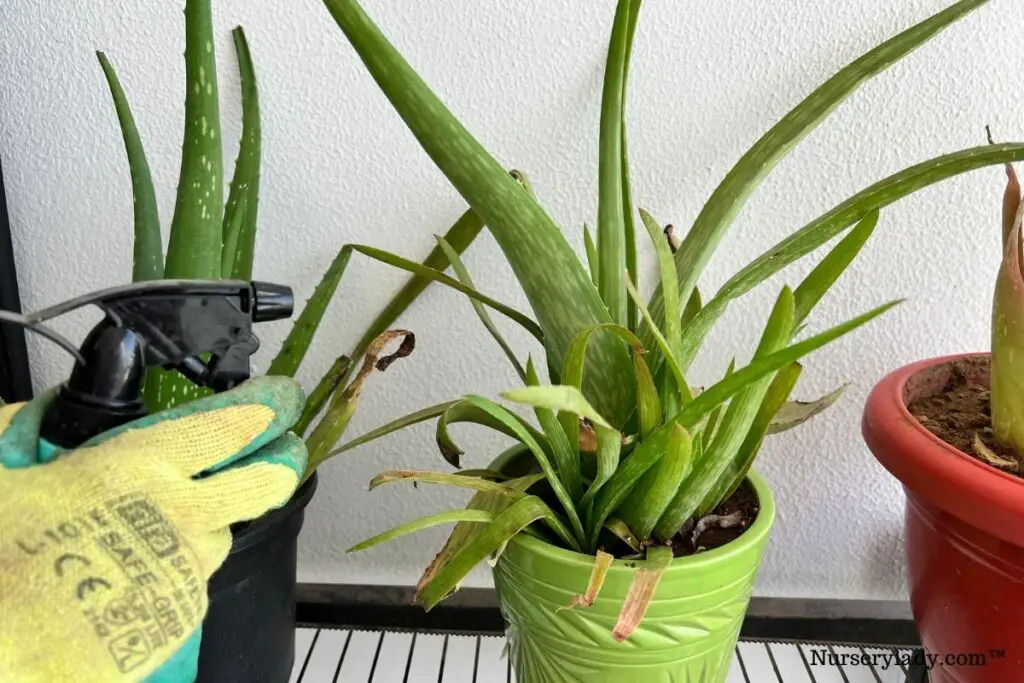
If you don’t notice any other problem in your aloe vera, the problem might be pests.
Most pests are so tiny that you can’t notice if you don’t check the plant thoroughly or use a magnifying glass.
Here are some bugs that can attack your aloe vera are aphids, mealybugs, aloe mites, scales, etc.
These bugs feed on the sap out of the aloe vera, which contains the plant’s nutrients.
Therefore, your aloe vera becomes weak, the leaves lose their color and become yellow.
With pest infestations, leaves can turn partially or entirely yellow.
Solution:
If you have a pest-infested aloe vera plant, you should start the treatment immediately.
- Isolate your aloe vera if you have other houseplants as you don’t want other plants to get the pests.
- You can give the plant a thorough wash to get rid of the pests but let the plant dry out after that.
- Use a cotton ball by dipping it in rubbing alcohol and applying it over the affected parts.
- Spray a neem oil solution all over the plant to remove the pests.
- If nothing works, you can get a commercial pesticide and spray it on your aloe vera plant.
- If you notice any heavily infected part, prune it.
If you want to prevent pest infestations, spray a neem oil solution on the plant once a month and keep it in a well-ventilated spot.
Aloe vera doesn’t need high humidity, so if you give it excess humidity or water, it will get pests.
You should also avoid keeping your aloe vera too thirsty as it can cause spider mite infestation.
Diseases
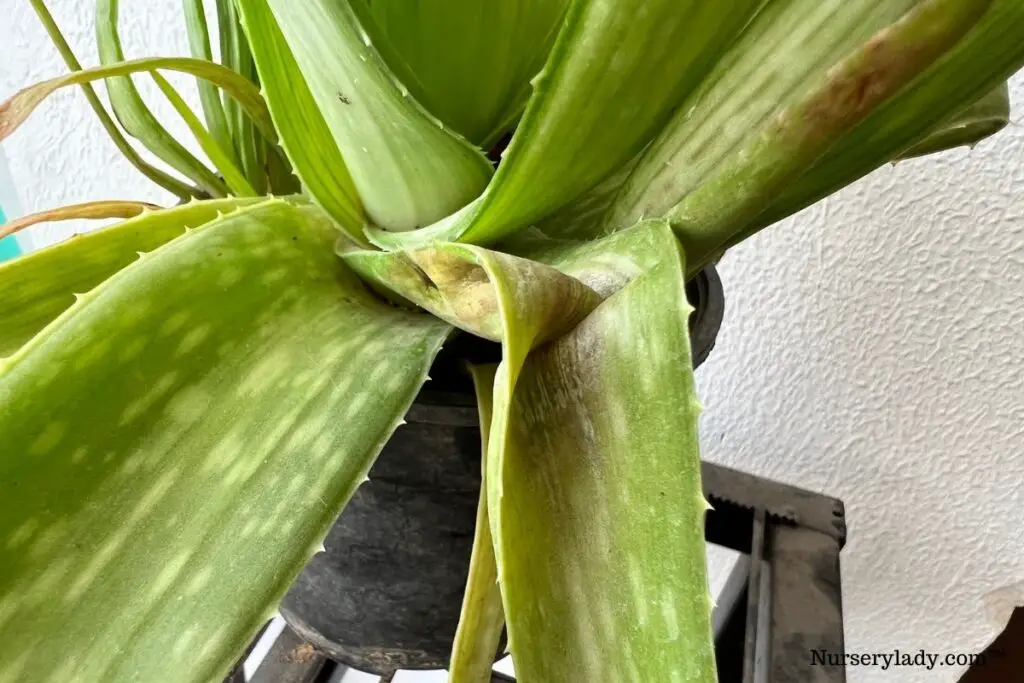
I already mentioned root rot in the overwatering point, and it is a deadly fungal disease that can kill the aloe vera.
Other fungal diseases that can cause yellow leaves on your aloe vera are:
- Bacterial soft rot
- Aloe rust
- Basal stem rot
All these diseases are extremely harmful, and in most cases, you might not be able to save your aloe vera.
Therefore, it is better to prevent these by keeping the aloe vera plant in the ideal conditions.
But if your aloe vera has any of these diseases, you should prune the affected parts and the yellow leaves.
This might stop the further spread of the disease.
If your aloe vera has a disease, the yellowing will start from the base and eventually move up.
The yellow leaves might also develop brown spots.
Repotting shock
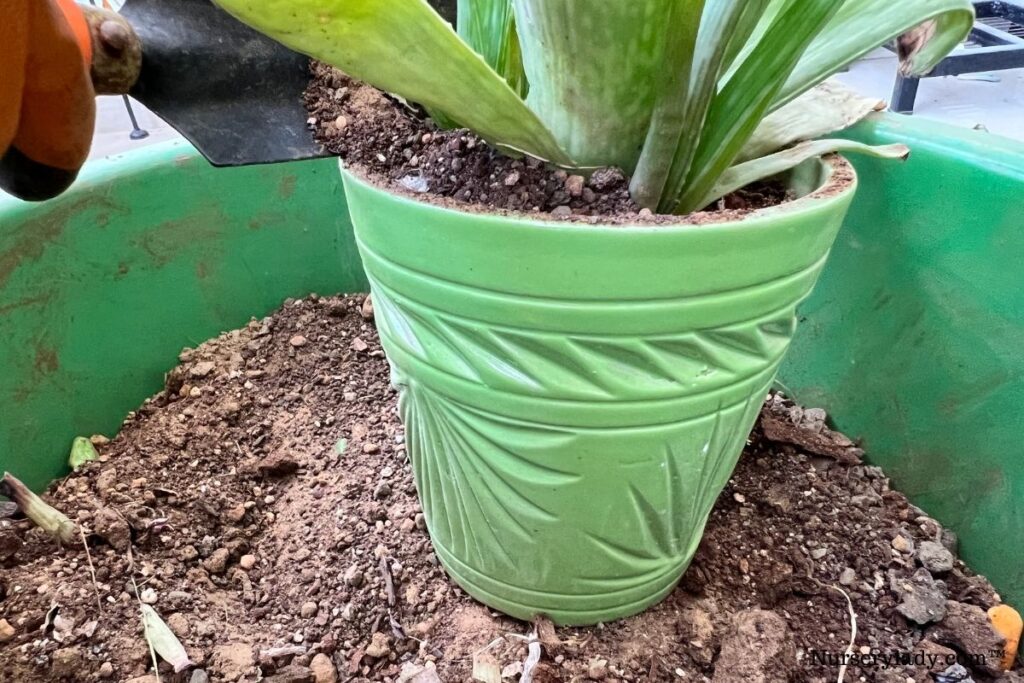
All plants undergo repotting shock whenever you repot it.
This is because repotting is a big change for the plants.
You might notice yellow, droopy, or falling leaves if you have repotted or transplanted your aloe vera recently.
You will not have anything much to do here except provide the proper growing conditions to the plant and wait for it to adjust to the changes.
Once your aloe vera is acquainted with the new pot and soil, it will stop producing yellow leaves.
Also read: Does Aloe Vera Plant Like To Be Root Bound? (Possible Problems+Repot)
Should I cut off yellow aloe leaves?
Yes, you should prune the yellow leaves as they have no chance of turning green again.
You can leave the yellow leaves on your aloe vera plant only if it is underwatered or under fertilized.
In these cases, the leaves might turn green.
How do I care for my aloe vera plant?
After you identify the problem and treat it, you need to take proper care of the plant to help it become green again.
| Factor | Basic Care |
|---|---|
| Light | Provide at least 6 hours of direct sunlight to your aloe vera plant and save it from too intense sunlight. If your aloe is not getting enough light, use artificial lights. |
| Water | You should water your aloe vera once in 2-3 weeks during summer and spring and once in 4-5 weeks in winter. Make sure that the soil is ready for watering by checking the moisture. |
| Soil | You can use any commercial succulent mix or add equal parts of potting soil and pumice for your aloe vera. For more information, read our aloe vera soil article. |
| Fertilizer | Aloe vera needs very little fertilizing. Fertilizing your aloe vera 1-2 times a year is sufficient. |
| Temperature | Aloe vera will thrive if you provide 60-75°F temperatures. You must not expose it to frost, drafts, or temperature fluctuations. |
| Humidity | Aloe vera will not need any extra humidity, and it will handle low humidity levels well. |
Reference: NCBI, New York Botanical Garden, University of New Hampshire, University of Florida, Wikipedia.
